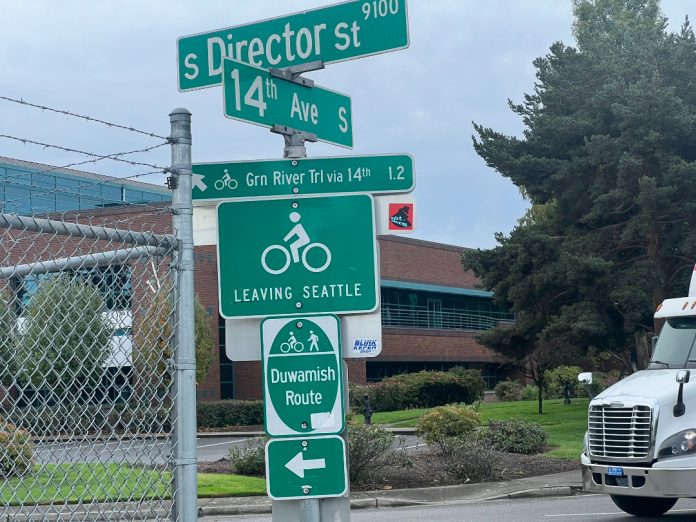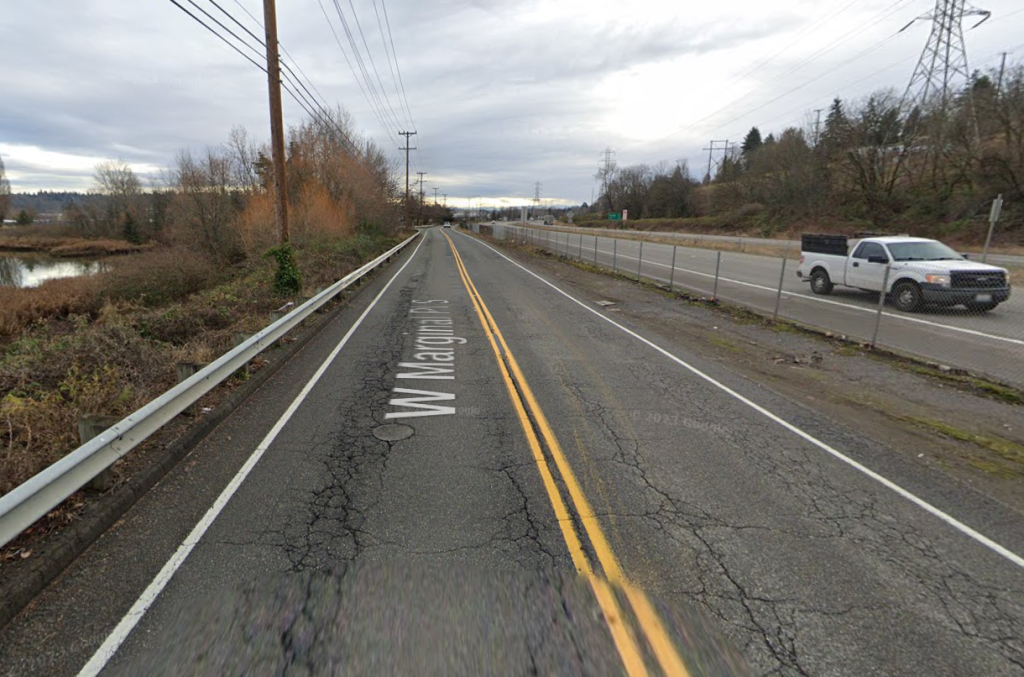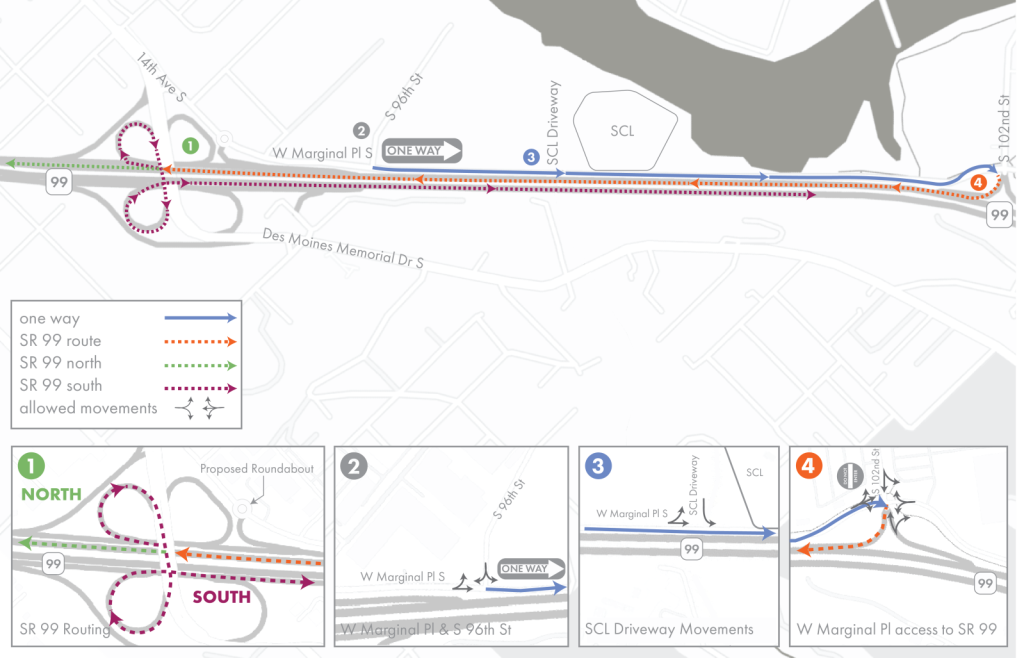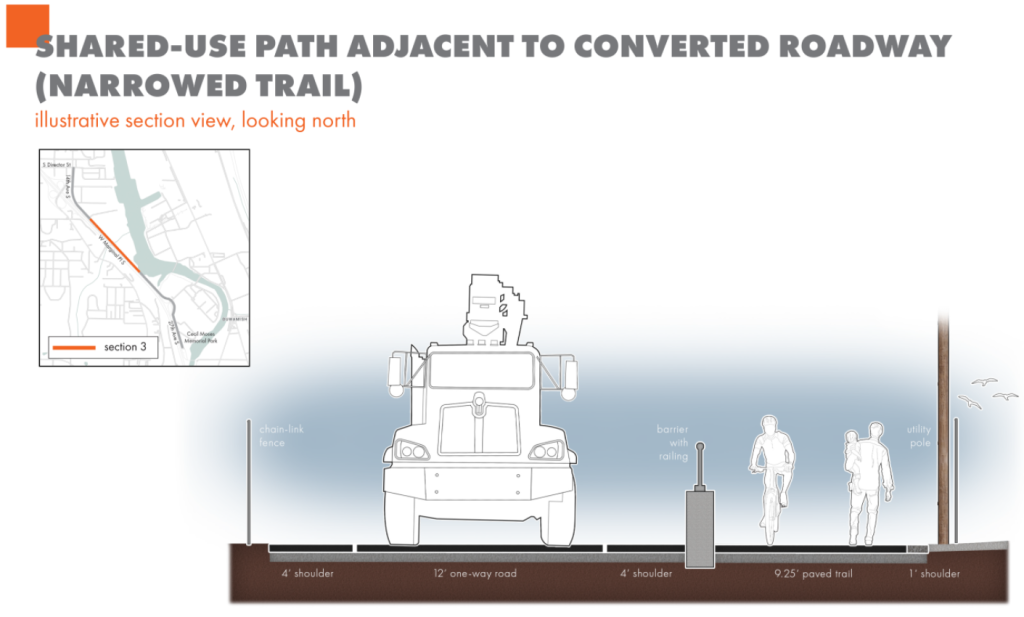
Users of the Green River Trail through South King County will have a considerably longer wait for a long-promised trail connection to Seattle, due to delays by King County to finalizing the design for a planned 1.4-mile segment that connects to Seattle’s city limits. Originally set to start construction by 2021, the project is now not scheduled to break ground until 2026, with an opening planned for the following year. If achieved, that timeline will mark a full decade between the official start of outreach and the completion of this vital link in the county’s trail network.
The trail will mostly run alongside West Marginal Place S, a two-lane frontage road to State Route 99 that trail users currently have to brave if they want to get onto the Green River Trail from Seattle’s South Park neighborhood. The existing roadway has minimal shoulders on either side, and walking to the trail requires sharing the road with freight traffic accessing the neighboring businesses. As part of this project, King County will also be widening a segment of the existing Green River Trail north of Cecil Moses Memorial Park in Tukwila.

Delays securing full funding for construction, along with determining a design that could be implemented along the narrow right-of-way available along West Marginal Place S, were cited as factors that contributed to the significant delay. This fall, King County has released 30% designs for the project and is conducting an additional phase of outreach. Final design isn’t expected to be reached until 2025, a testament to the slow pace of project development at the county level.
“Securing the funding from 30% design through construction got held up for a few years,” Doug Williams, spokesperson for King County Department of Natural Resources and Parks, told The Urbanist. “Over two plus years, we worked with [Washington State Department of Transportation], then Seattle City Light, then King County Roads to nail down the routing for the trail. We studied traffic and needed to develop concepts and preliminary designs for several different alternatives while working with these groups. In addition, we’ve extended the schedule again to accommodate a longer-than-expected timeframe for permitting and establishing agreements. So we’re getting there – slowly but surely.”

Because most of the new trail’s width is being reallocated from what’s currently W Marginal Place S, construction will prompt a permanent shift in the traffic patterns around the trail, with only a southbound lane for general purpose traffic planned to remain on the street. Drivers heading northbound will head south before using the adjacent state highway to head north again. Drivers who are ultimately heading south on SR 99 will need to head back north and use the interchange at Des Moines Memorial Drive to cross the highway and head back south.

A parcel of land containing a Seattle City Light substation was a substantial cause of headaches for the project team. With very little land available to create an easement, the trail is now planned to narrow considerably from the twelve feet, with four feet of shoulders, that is planned along the rest of the connection. Along the central segment of the trail (section 3 in the map above), the trail will only be nine-and-a-half feet wide, with a tiny one foot shoulder. This constrained segment will still represent a big upgrade compared to today.

This connection is one of the smallest projects that King County Natural Resources and Parks is currently working on, with new trails planned in multiple corners of the county. South King County is set to get a lot more connectivity when the Lake to Sound Trail, connecting Renton to Des Moines, finally opens. Last month, the county opened the final segment of the East Lake Sammamish Trail on the Eastside, connecting Redmond with Issaquah. Both of those projects had very long timelines, opening in disjointed segments, a different approach than most transportation departments take with their road projects.
It will still be up to Seattle to fund improvements that connect this trail to the rest of the city, with the Duwamish Trail through South Park currently just a signed sidewalk. The Georgetown to South Park Trail, currently set to start construction in the coming months, won’t actually extend onto the south end of the South Park bridge at all, leaving the question of creating a safe space on 14th Avenue S for another transportation levy, if at all. Savvy cyclists can navigate through South Park to the grade-separated Duwamish Trail to connect to West Seattle, but that route currently isn’t intuitive and speak to a need for more on-street connections.
Finally connecting Seattle with the Green River Trail, which runs nearly 20 miles through South King County and also connects to the Interurban Trail, will be invaluable for trail users, especially those connecting to and from South Park. A full decade is a long time to wait for a relatively short trail connection, and the question remains as to whether the county could have done anything to shorten that timeline, but by the time it opens, it will have been worth the wait.
Ryan Packer has been writing for The Urbanist since 2015, and currently reports full-time as Contributing Editor. Their beats are transportation, land use, public space, traffic safety, and obscure community meetings. Packer has also reported for other regional outlets including BikePortland, Seattle Met, and PubliCola. They live in the Capitol Hill neighborhood of Seattle.

